Post by Stingray on Jul 14, 2008 20:03:10 GMT -4
Mil Mi-2 "Hoplite"
1961
--------------------------------------------------------------------------------
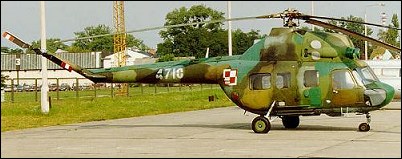
www.aviastar.org/helicopters_eng/mi-2.php
The Mi-2 is basically a turbine-powered development of the Mi-1 in which, by mounting two small shaft turbine engines above the fuselage, the entire cabin area can be made available for a payload. First announced in autumn 1961, the Mi-2 was flown for the first time two years later and is powered by two 400shp Isotov GTD-350 shaft turbine engines mounted side by side above the cabin. It is designed for a similar range of light utility duties to those performed by the Mi-1 and in its passenger form can carry 7 people in addition to the pilot. In the ambulance role it can accommodate 4 stretchers and a medical attendant; as a freighter, it can carry 700kg of cargo. For flying crane or rescue duties it can be fitted with an under-fuselage hook for a sling load of 800kg or a winch over the cabin door capable of lifting up to 150kg. The Mi-2's fourth main application is in the agricultural role, for which it can carry a hopper on either side of the cabin containing 450kg of dry chemical or 500l of liquid; on non-agricultural Mi-2's these containers can be replaced by additional fuel tanks. The Mi-2 is being built by WSK's Mielec factory in Poland, following negotiations begun in January 1964 whereby WSK has exclusive production rights for both the airframe and its engines. It may be supposed that it will replace the Mi-1 in a number of military roles, and will be particularly valuable to Aeroflot as an ambulance and air taxi. Some Mi-2's are believed to have been supplied to the United Arab Republic, whence a number may have fallen into Israeli hands.
--K.Munson "Helicopters And Other Rotorcraft Since 1907", 1968
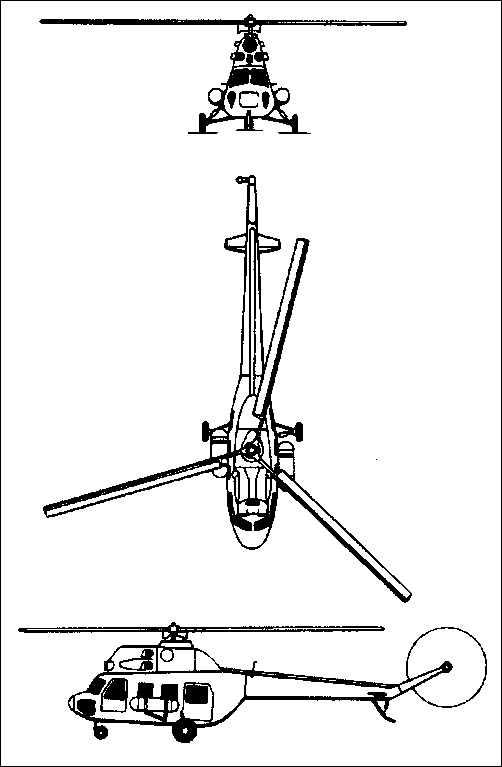
In the mid fifties, the Mil bureau decided to improve the performance of the Mi-1 by developing a turbine-powered version. Two of the new Isotov GTD-350 free-turbine engines were chosen. A free-turbine engine enables the r.p.m. of the rotor to be varied, whilst those of the engine are kept constant. For half the weight of the earlier piston engine, the two GTD-350 developed 40% more power. They were installed side-by-side above the fuselage, considerably increasing the available cabin space. The first prototype, designated V-2 and then Mi-2, flew in September 1961; it had the same rotor, transmission and tail unit as the Mi-1. After preliminary trials, a metal tail rotor was adopted (the Mi-1 had a wooden one) and later, from 1965, a new main rotor hub derived from that of the Mi-6.
As the Russian plants were fully occupied with production of the Mi-8 and other heavy helicopters in the Mil series, an agreement was reached with WSK-Swidnik to manufacture the Mi-2 in Poland, and they took over production and development rights in 1964. The first Polish Mi-2 had flown before this in November 1963, and once trials were completed, large-scale production began in 1965. The first production aircraft had 400shp engines, but from 1974 these were uprated to 450shp. Another modification was the use of fiberglass materials for the main rotor, tail rotor and stabilizer, to simplify production and improve performance.
Various versions of the Mi-2 have been built for civil and military use. One in service with the Polish Air Force is equipped with rocket launchers and air-to-ground missiles, slung from rails at the sides of the fuselage. The Mi-2 is still in production. Most of the aircraft built have been exported to the Soviet Union and other Warsaw Pact countries.
--G.Apostolo "The Illustrated Encyclopedia of Helicopters", 1984

Following the licence production of 1,700 Mi-1 'Hare' Soviet helicopters built under licence from 1955 onwards, the Polish Swidnik factory was assigned the development, production and marketing rights to the turbine-powered Mi-2 development in January 1964 and the first Polish-built example flew in November 1965. Designed by Mikhail Mil and first flown in the USSR in September 1961, the Mi-2, codenamed, 'Hoplite' by NATO, retained the basic three-bladed main rotor and starboard side tail rotor configuration of the Mi-1, but with a larger cabin and two Isotov turboshaft engines mounted side-by-side above the cabin replacing the earlier piston power-plant. The Mi-2 has undergone continuous refinement and adaptation to special versions and more than 5,250 had been built when production was suspended in 1991 pending privatisation of the company planned for 1992. Optimised export versions of the Mi-2 have been developed for sale in the West under the names Kania/Kitty Hawk and Taurus.
VARIANTS
Mi-2: standard civil version available as convertible 6/8-passenger or cargo transport, crop sprayer (identified as the Bazant), pilot trainer, aerial photography, photogrammetry or as freight hauler with external sling and electric hoist
Mi-2B: basic Mi-2 but with updated navaids and modified electrical system,, and without rotor blade de-icing
Mi-2R: air ambulance and search and rescue version of Mi-2 fitted with an electric hoist
Mi-2RM: naval version
Mi-2URN: 1973 variant of Mi-2US gunship but with two Mars 2 launcher pods (each containing 16 57-mm unguided rockets) for close air support or armed recce
Mi-2URP: 1976 anti-tank version with four pylon-mounted AT-3 'Sagger' ATMs plus four more in cargo compartment; later models able to carry four 'Strela 2' missiles
Mi-2US: gunship version equipped with NS-23KM 23-mm cannon on port side of fuselage, two pylon-mounted 7.62mm machine-gun pods on fuselage sides, plus two trainable 7.62mm machine-guns mounted in rear of cabin
--D.Donald "The Complete Encyclopedia of World Aircraft", 1997
Chronologically later than Mi-4 and Mi-6, Mi-2 was planned 1958-59 as modernized turbine derivative of Mi-1, just as Mi-8 was to Mi-4. Originally Mi-1 dynamic parts retained and mated with completely new fuselage, all light-alloy monocoque with steel forgings at concentrated loads, with twin turboshaft engines above cabin ahead of gearbox. Structural basis deep floor box carrying wheel or ski landing gears and housing flexible fuel cell of 600 lit. Normal accommodation for pilot and passenger (on right) with main cabin for 700kg cargo or seat unit for three passengers facing forward and three facing aft, with eighth passenger seat on right opposite rear door. Option of four stretchers and attendant, or slung load of 1.2t or two 600 lit ag containers. All versions plumbed for two 250-lit auxiliary tanks on sides.
First flight of V-2 Sept 1961. Subsequently developed as production Mi-2 with bonded/welded fuselage, hub with hydraulic instead of friction dampers, bleed-air anticed intakes, tail rotor with bonded-metal honeycomb blades and electro-thermal de-icing on all blades. Whole program transferred to WSK-Swidnik in Poland in Jan 1964. All production and development subsequently at WSK, involving 12 series versions including SAR, photo, anti-armour and gunship. Total by 1993 over 5320. ASCC name "Hoplite".
--Bill Gunston "The Osprey's Encyclopedia of Russian Aircraft", 2000
Designed in USSR by Mikhail L Mil and first flown 22 September 1961; January 1964 agreement assigned further development, production and marketing exclusively to Polish industry; first flight of Polish example 4 November 1965; series production began 1965. Has undergone continuous development and upgrading, with versions for new applications developed to meet specific customers' requirements. Production at standstill early 1992, but reported continuing on limited basis.
VERSIONS
Mi-2: Basic civil version.
Mi-2B: Different electrical system and more modern navigational aids; manufactured in same versions (except agricultural) as basic Mi-2, and has same flight performance; empty equipped weights 2,300kg for passenger version, 2,293kg for cargo version; T-O weight unchanged; no rotor blade de-icing. Production total not large.
Mi-2Ch Chekla: Radiation reconnaissance and smoke-laying conversion.
Mi-2D Przetacznik: Airborne Command Post with radio communication, cipher and telephone equipment.
Mi-2FM Kajman: Photogrammetry version. Only two built.
Mi-2P: Standard eight-seat passenger, convertible all-cargo version with external sling and electric hoist.
Mi-2 Platan: Minelaying conversion.
Mi-2R: Agricultural version for conventional or Ultra Low Volume (ULV) dusting and spraying. Chemical hoppers mounted on each side of the fuselage; capacity 500 litres liquid or 375kg dry chemicals. Empty weight 2,372kg.
Mi-2RL: SAR version for land use.
Mi-2RM Anakonda: SAR version for naval use with two-person electric winch over port side door and air-droppable dinghies. Nine built for Polish Naval Air Arm.
Mi-2Ro: Military reconnaissance version.
Mi-2RS Padalec: Special contamination reconnaissance version.
Mi-2S: Medevac version equipped for four litters plus attendant or two litters and two sitting patients.
Mi-2Sz: Dual-control training version.
Mi-2T: Military transport version.
Mi-2URN: Combat support/armed reconnaissance version; as Mi-2US but with two Mars 2 launchers (each 16 S-5 57mm unguided rockets) instead of pylon-mounted gun pods; PKV gunsight in cockpit for aiming all weapons; in service from 1973.
Mi-2URP Salamandra: Anti-tank version; cabin side outriggers for four 9M14M Malyutka (AT-3 'Sagger') wire-guided missiles; four additional missiles in cargo compartment; in service from 1976.
Mi-2URPG Gniewosz: Similar to Mi-2URP but with four Gad (9M32 Strela 2/SA-7 'Grail') anti-aircraft missiles.
Mi-2US Adder: Gunship version; 23mm NS-23KM cannon on port side of fuselage, two 7.62mm gun pods on each side pylon, two other 7.62mm PK-type pintle-mounted machine guns in rear of cabin.
UMi-2Ro: Reconnaissance training version.
CUSTOMERS: Total 5,450 built for civil and military operators by January 1999, majority exported.
DESIGN FEATURES: Three-blade main rotor with hydraulic blade vibration dampers; flapping, drag and pitch hinges on each blade; anti-flutter weights on leading-edges, balancing plates on trailing-edges. Coil spring counterbalance in main and tail rotor systems; pitch change centrifugal loads on tail rotor carried by ribbon-type steel torsion elements. Blades do not fold; rotor brake fitted. Main rotor blade section NACA 230-12M. Main rotor shaft driven via gearbox on each engine; three-stage WR-2 main gearbox, intermediate gearbox and tail rotor gearbox; main rotor/engine rpm ratio 1:24.6, tail rotor/engine rpm ratio 1:4.16; main gearbox provides drive for auxiliary systems and take-off for rotor brake; freewheel units permit disengagement of failed engine and autorotation.
FLYING CONTROLS: Hydraulic system for cyclic and collective pitch control boosters; variable incidence horizontal stabiliser, controlled by collective pitch lever.
STRUCTURE: Main and tail rotor blades have extruded duralumin spar with bonded honeycomb trailing-edge pockets; pod and boom fuselage of sheet duralumin, bonded and spot welded or riveted or longerons and frames, in three main assemblies (nose including cockpit, central section and tailboom); steel alloy main load-bearing joints.
LANDING GEAR: Non-retractable tricycle type, plus tailskid. Twin-wheel nose unit. Single wheel on each main unit. Oleo-pneumatic shock-absorbers in all units, including tailskid. Main shock-absorbers designed to cope with both normal operating loads and possible ground resonance. Mainwheel tyres size 600 x 180, pressure 4.41 bars. Nosewheel tyres size 400 x 125, pressure 3.45 bars. Pneumatic brakes on mainwheels. Metal ski landing gear optional.
POWER PLANT: Two 313kW Polish-built Isotov GTD-350 turboshafts, mounted side by side above cabin. Fuel in single rubber tank, capacity 600 litres, under cabin floor. Provision for carrying 238 litre external tank on each side of cabin. Refuelling point in starboard side of fuselage. Oil capacity 25 litres.
ACCOMMODATION: Normal accommodation for one pilot on flight deck (port side). Seats for up to eight passengers in air conditioned cabin, comprising back to back bench seats for three persons each, with two optional extra starboard side seats at rear, one behind the other. All passenger seats removable for carrying up to 700kg of internal freight. Access to cabin via forward-hinged doors on each side at front of cabin and aft on port side. Pilot's sliding window jettisonable in emergency. Ambulance version has accommodation for four stretchers and medical attendant, or two stretchers and two sitting casualties. Side by side seats and dual controls in pilot training version. Cabin heating, ventilation and air conditioning standard.
SYSTEMS: Cabin heating, by engine bleed air, and ventilation; heat exchangers warm atmospheric air for ventilation system during cold weather. Hydraulic system, pressure 65 bars, for cyclic and collective pitch control boosters. Hydraulic fluid flow rate 7.5 litres/min. Vented reservoir, with gravity feed. Pneumatic system, pressure 49 bars, for mainwheel brakes. AC electrical system, with two STG-3 3kW engine-driven starter/generators and 208V 16kVA three-phase alternator. 24V DC system, with two 28Ah lead-acid batteries. Main and tail rotor blades de-iced electrically; engine air intake de-icing by engine bleed air. Electric de-icing of windscreen.
AVIONICS: Standard items include two transceivers (MF/HF), gyrocompass, radio compass, radio altimeter, intercom system and blind-flying panel. Nose and tail warning radar fitted to some military versions.
EQUIPMENT: Agricultural version carries hopper on each side of fuselage (total capacity 1,000 litres of liquid or 750kg of dry chemical) and either a spraybar to rear of cabin on each side or distributor for dry chemicals under each hopper. Swath width covered by spraying version is 40 to 45m. For search and rescue, electric hoist, capacity 120kg, is fitted. In freight role an underfuselage hook can be fitted for suspended loads of up to 800kg. Polish press has illustrated version equipped for laying smokescreens. Electrically operated wiper for pilot's windscreen. Freon fire extinguishing system, for engine bays and main gearbox compartment, can be actuated automatically or manually.
ARMAMENT: See Versions.
--Jane's Helicopter Markets and Systems
* * *
The Mil Mi-2, which has the NATO reporting name Hoplite, was first announced in the autumn of 1961, and is essentially the Mi-1 updated in the light of operating experience with the Mi-6. The Mi-2 thus has very distinct similarities to the Mi-1 in size and structure, but uses a twin-turboshaft powerplant giving the type about 2 1/2 times the Mi-1's payload. Whereas the Mi-1's engine and transmission constitute about 25% of the aircraft's weight, that of the Mi-2 is only about 12.5% of the weight, but develops some 40% more power. The first Mi-2 flew in 1962, and was put through its trials fairly quickly. A measure of the type's ability was the establishment of a class speed record of 269.38km/h on June 20, 1965, when piloted by Tatyana Russyan.
With the completion of Russian state trials, Mi-2 production began at the WSK-PZL factory at Swidnik in Poland. Construction is of the standard semi-monocoque duralumin type, with the engine and transmission assembly above the cabin. This last seats six passengers three-abreast and in two back-to-back rows, with two optional extra left-hand seats at the rear, one behind the other.
The type is produced in a variety of forms: the passenger model can be stripped of seats to provide space to carry up to 1000kg of freight; the Mi-2R is an ambulance model carrying up to four litters and an attendant; the agricultural model is fitted with two 600-litre external tanks and their attached chemical spray spreaders; the rescue model is fitted with a winch which has a capacity of 120kg; the flying-crane model has 30m of cable and a hook capable of lifting 1200kg; and there are also pilot-training, photogrammetric survey and TV broadcast models.
Each individual rotor blade used to be of typical Mil construction, with some 20 bonded sections attached to a light alloy spar, with a light aluminium honeycomb trailing edge, the whole being covered in light alloy sheet. WSK-PZL-Swidnik have since developed a more advanced rotor blade based on an extruded duralumin spar with plastic sections and covering.
Further development of the Mi-2 has been undertaken by WSK-PZL-Swidnik with a view to selling the type to western countries. The result is the Kania or Kitty Hawk, powered by two Allison turboshafts.
--Bill Gunston "The Illustrated Encyclopedia of Commercial Aircraft", 1980
* * *
--------------------------------------------------------------------------------
Photo Gallery
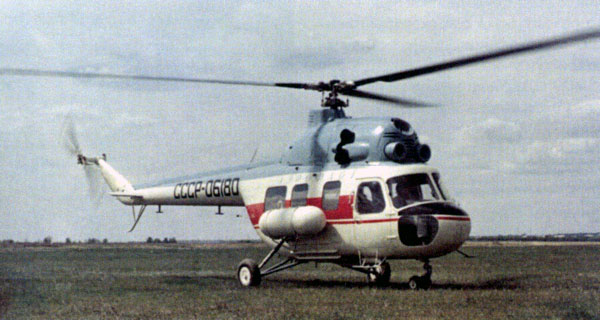
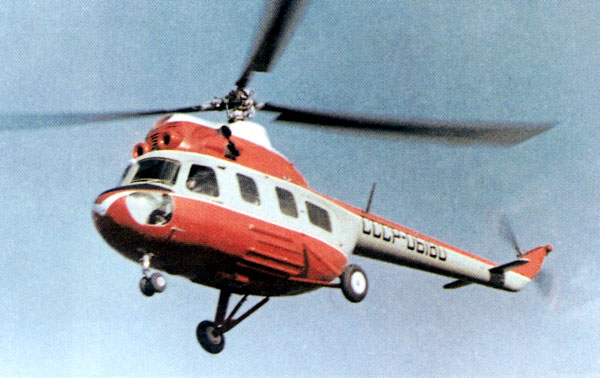
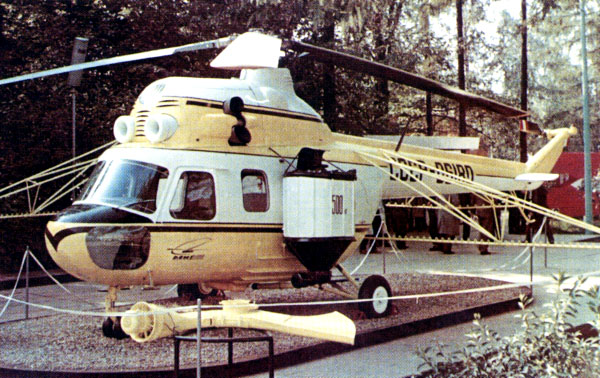
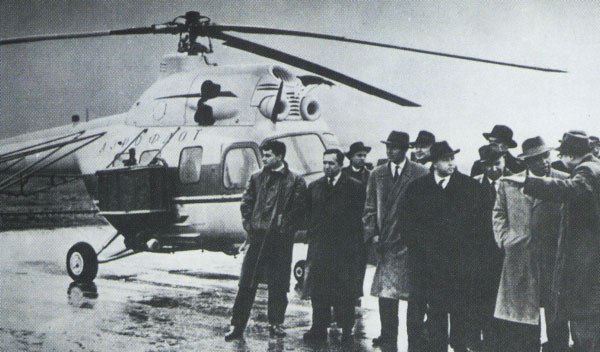
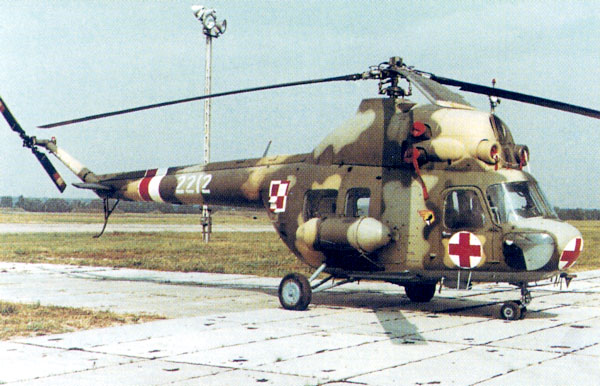
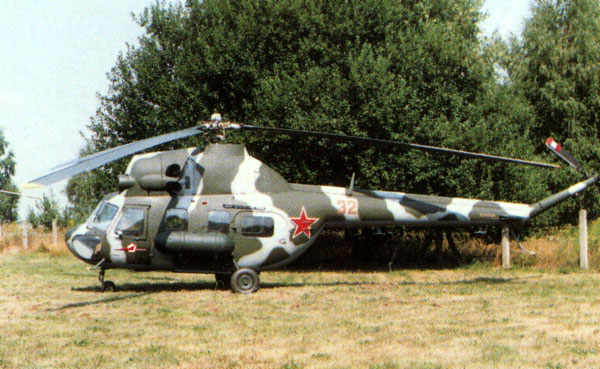
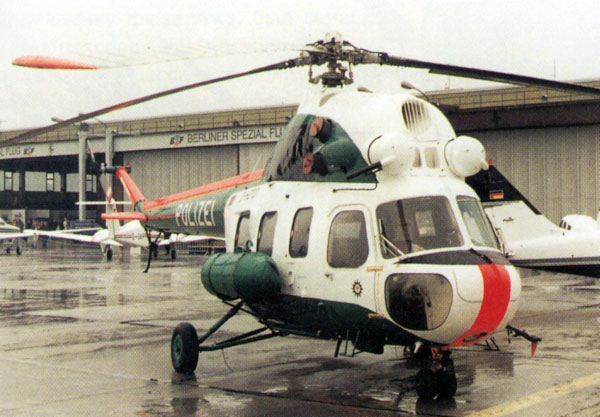

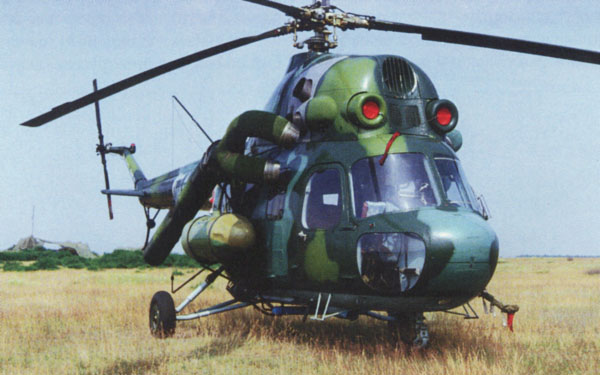
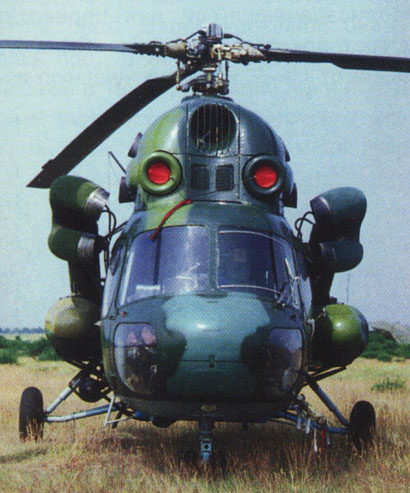
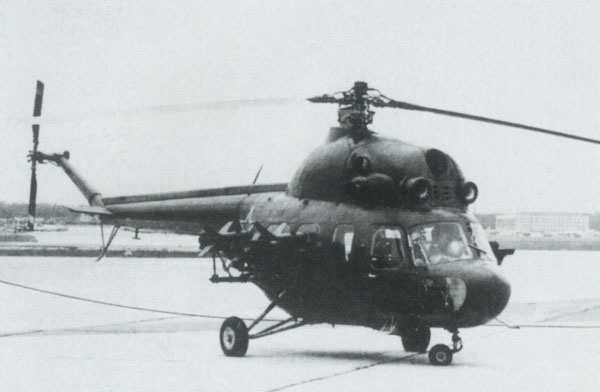

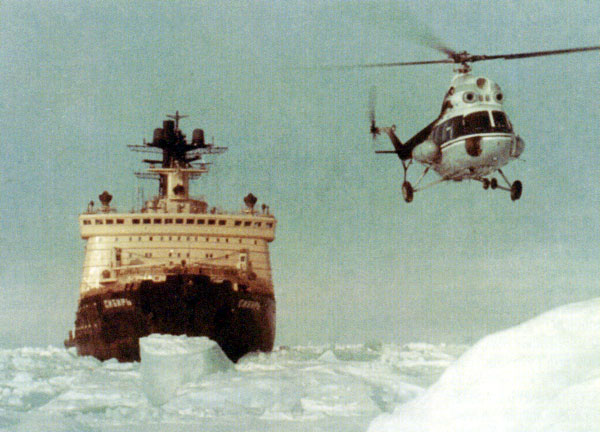
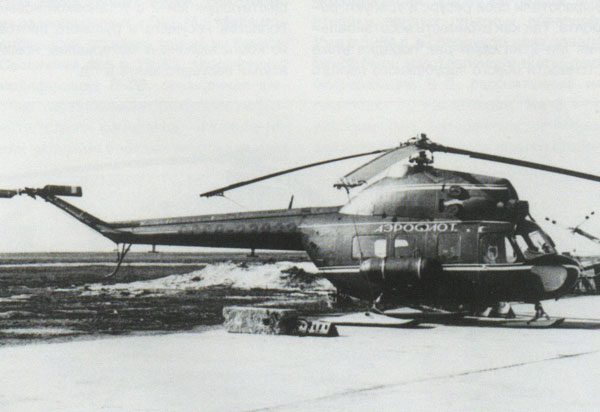
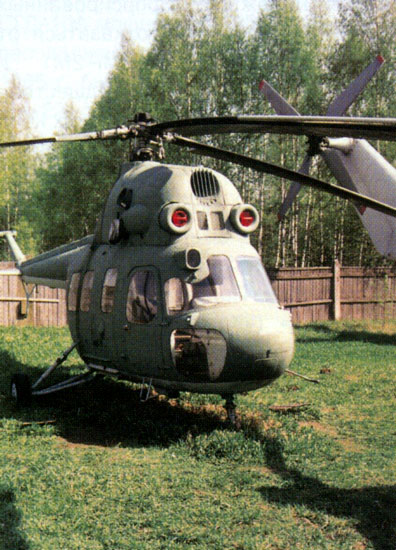
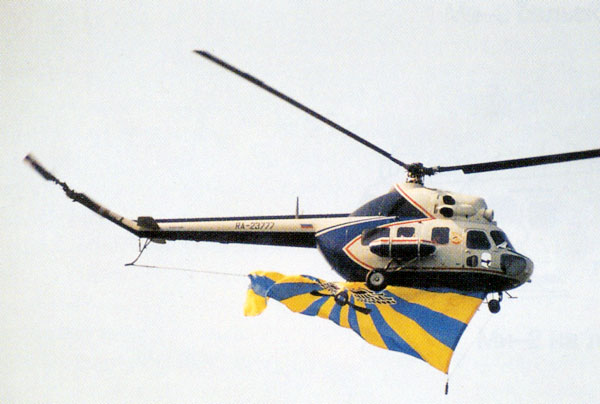

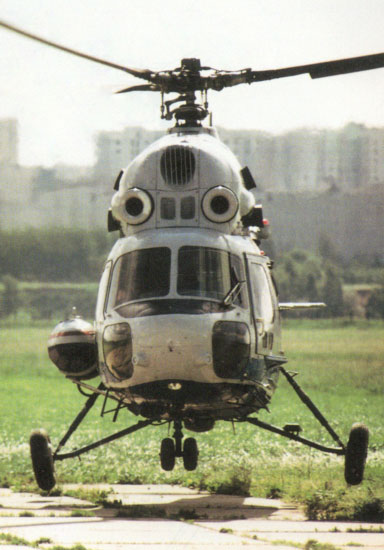
--------------------------------------------------------------------------------
Technical data for Mi-2M
Crew: 1-2, passengers: 8, engine: 2 x Izotov GTD-350P turboshaft, rated at 331kW, main rotor diameter: 14.5m, length with rotors turning: 17.42m, height: 3.75m, take-off weight: 3550kg, empty weight: 2402kg, max speed: 210km/h, cruising speed: 200km/h, service ceiling: 4000m, range with max payload: 170km, payload: 800kg
1961
--------------------------------------------------------------------------------

www.aviastar.org/helicopters_eng/mi-2.php
The Mi-2 is basically a turbine-powered development of the Mi-1 in which, by mounting two small shaft turbine engines above the fuselage, the entire cabin area can be made available for a payload. First announced in autumn 1961, the Mi-2 was flown for the first time two years later and is powered by two 400shp Isotov GTD-350 shaft turbine engines mounted side by side above the cabin. It is designed for a similar range of light utility duties to those performed by the Mi-1 and in its passenger form can carry 7 people in addition to the pilot. In the ambulance role it can accommodate 4 stretchers and a medical attendant; as a freighter, it can carry 700kg of cargo. For flying crane or rescue duties it can be fitted with an under-fuselage hook for a sling load of 800kg or a winch over the cabin door capable of lifting up to 150kg. The Mi-2's fourth main application is in the agricultural role, for which it can carry a hopper on either side of the cabin containing 450kg of dry chemical or 500l of liquid; on non-agricultural Mi-2's these containers can be replaced by additional fuel tanks. The Mi-2 is being built by WSK's Mielec factory in Poland, following negotiations begun in January 1964 whereby WSK has exclusive production rights for both the airframe and its engines. It may be supposed that it will replace the Mi-1 in a number of military roles, and will be particularly valuable to Aeroflot as an ambulance and air taxi. Some Mi-2's are believed to have been supplied to the United Arab Republic, whence a number may have fallen into Israeli hands.
--K.Munson "Helicopters And Other Rotorcraft Since 1907", 1968

In the mid fifties, the Mil bureau decided to improve the performance of the Mi-1 by developing a turbine-powered version. Two of the new Isotov GTD-350 free-turbine engines were chosen. A free-turbine engine enables the r.p.m. of the rotor to be varied, whilst those of the engine are kept constant. For half the weight of the earlier piston engine, the two GTD-350 developed 40% more power. They were installed side-by-side above the fuselage, considerably increasing the available cabin space. The first prototype, designated V-2 and then Mi-2, flew in September 1961; it had the same rotor, transmission and tail unit as the Mi-1. After preliminary trials, a metal tail rotor was adopted (the Mi-1 had a wooden one) and later, from 1965, a new main rotor hub derived from that of the Mi-6.
As the Russian plants were fully occupied with production of the Mi-8 and other heavy helicopters in the Mil series, an agreement was reached with WSK-Swidnik to manufacture the Mi-2 in Poland, and they took over production and development rights in 1964. The first Polish Mi-2 had flown before this in November 1963, and once trials were completed, large-scale production began in 1965. The first production aircraft had 400shp engines, but from 1974 these were uprated to 450shp. Another modification was the use of fiberglass materials for the main rotor, tail rotor and stabilizer, to simplify production and improve performance.
Various versions of the Mi-2 have been built for civil and military use. One in service with the Polish Air Force is equipped with rocket launchers and air-to-ground missiles, slung from rails at the sides of the fuselage. The Mi-2 is still in production. Most of the aircraft built have been exported to the Soviet Union and other Warsaw Pact countries.
--G.Apostolo "The Illustrated Encyclopedia of Helicopters", 1984

Following the licence production of 1,700 Mi-1 'Hare' Soviet helicopters built under licence from 1955 onwards, the Polish Swidnik factory was assigned the development, production and marketing rights to the turbine-powered Mi-2 development in January 1964 and the first Polish-built example flew in November 1965. Designed by Mikhail Mil and first flown in the USSR in September 1961, the Mi-2, codenamed, 'Hoplite' by NATO, retained the basic three-bladed main rotor and starboard side tail rotor configuration of the Mi-1, but with a larger cabin and two Isotov turboshaft engines mounted side-by-side above the cabin replacing the earlier piston power-plant. The Mi-2 has undergone continuous refinement and adaptation to special versions and more than 5,250 had been built when production was suspended in 1991 pending privatisation of the company planned for 1992. Optimised export versions of the Mi-2 have been developed for sale in the West under the names Kania/Kitty Hawk and Taurus.
VARIANTS
Mi-2: standard civil version available as convertible 6/8-passenger or cargo transport, crop sprayer (identified as the Bazant), pilot trainer, aerial photography, photogrammetry or as freight hauler with external sling and electric hoist
Mi-2B: basic Mi-2 but with updated navaids and modified electrical system,, and without rotor blade de-icing
Mi-2R: air ambulance and search and rescue version of Mi-2 fitted with an electric hoist
Mi-2RM: naval version
Mi-2URN: 1973 variant of Mi-2US gunship but with two Mars 2 launcher pods (each containing 16 57-mm unguided rockets) for close air support or armed recce
Mi-2URP: 1976 anti-tank version with four pylon-mounted AT-3 'Sagger' ATMs plus four more in cargo compartment; later models able to carry four 'Strela 2' missiles
Mi-2US: gunship version equipped with NS-23KM 23-mm cannon on port side of fuselage, two pylon-mounted 7.62mm machine-gun pods on fuselage sides, plus two trainable 7.62mm machine-guns mounted in rear of cabin
--D.Donald "The Complete Encyclopedia of World Aircraft", 1997
Chronologically later than Mi-4 and Mi-6, Mi-2 was planned 1958-59 as modernized turbine derivative of Mi-1, just as Mi-8 was to Mi-4. Originally Mi-1 dynamic parts retained and mated with completely new fuselage, all light-alloy monocoque with steel forgings at concentrated loads, with twin turboshaft engines above cabin ahead of gearbox. Structural basis deep floor box carrying wheel or ski landing gears and housing flexible fuel cell of 600 lit. Normal accommodation for pilot and passenger (on right) with main cabin for 700kg cargo or seat unit for three passengers facing forward and three facing aft, with eighth passenger seat on right opposite rear door. Option of four stretchers and attendant, or slung load of 1.2t or two 600 lit ag containers. All versions plumbed for two 250-lit auxiliary tanks on sides.
First flight of V-2 Sept 1961. Subsequently developed as production Mi-2 with bonded/welded fuselage, hub with hydraulic instead of friction dampers, bleed-air anticed intakes, tail rotor with bonded-metal honeycomb blades and electro-thermal de-icing on all blades. Whole program transferred to WSK-Swidnik in Poland in Jan 1964. All production and development subsequently at WSK, involving 12 series versions including SAR, photo, anti-armour and gunship. Total by 1993 over 5320. ASCC name "Hoplite".
--Bill Gunston "The Osprey's Encyclopedia of Russian Aircraft", 2000
Designed in USSR by Mikhail L Mil and first flown 22 September 1961; January 1964 agreement assigned further development, production and marketing exclusively to Polish industry; first flight of Polish example 4 November 1965; series production began 1965. Has undergone continuous development and upgrading, with versions for new applications developed to meet specific customers' requirements. Production at standstill early 1992, but reported continuing on limited basis.
VERSIONS
Mi-2: Basic civil version.
Mi-2B: Different electrical system and more modern navigational aids; manufactured in same versions (except agricultural) as basic Mi-2, and has same flight performance; empty equipped weights 2,300kg for passenger version, 2,293kg for cargo version; T-O weight unchanged; no rotor blade de-icing. Production total not large.
Mi-2Ch Chekla: Radiation reconnaissance and smoke-laying conversion.
Mi-2D Przetacznik: Airborne Command Post with radio communication, cipher and telephone equipment.
Mi-2FM Kajman: Photogrammetry version. Only two built.
Mi-2P: Standard eight-seat passenger, convertible all-cargo version with external sling and electric hoist.
Mi-2 Platan: Minelaying conversion.
Mi-2R: Agricultural version for conventional or Ultra Low Volume (ULV) dusting and spraying. Chemical hoppers mounted on each side of the fuselage; capacity 500 litres liquid or 375kg dry chemicals. Empty weight 2,372kg.
Mi-2RL: SAR version for land use.
Mi-2RM Anakonda: SAR version for naval use with two-person electric winch over port side door and air-droppable dinghies. Nine built for Polish Naval Air Arm.
Mi-2Ro: Military reconnaissance version.
Mi-2RS Padalec: Special contamination reconnaissance version.
Mi-2S: Medevac version equipped for four litters plus attendant or two litters and two sitting patients.
Mi-2Sz: Dual-control training version.
Mi-2T: Military transport version.
Mi-2URN: Combat support/armed reconnaissance version; as Mi-2US but with two Mars 2 launchers (each 16 S-5 57mm unguided rockets) instead of pylon-mounted gun pods; PKV gunsight in cockpit for aiming all weapons; in service from 1973.
Mi-2URP Salamandra: Anti-tank version; cabin side outriggers for four 9M14M Malyutka (AT-3 'Sagger') wire-guided missiles; four additional missiles in cargo compartment; in service from 1976.
Mi-2URPG Gniewosz: Similar to Mi-2URP but with four Gad (9M32 Strela 2/SA-7 'Grail') anti-aircraft missiles.
Mi-2US Adder: Gunship version; 23mm NS-23KM cannon on port side of fuselage, two 7.62mm gun pods on each side pylon, two other 7.62mm PK-type pintle-mounted machine guns in rear of cabin.
UMi-2Ro: Reconnaissance training version.
CUSTOMERS: Total 5,450 built for civil and military operators by January 1999, majority exported.
DESIGN FEATURES: Three-blade main rotor with hydraulic blade vibration dampers; flapping, drag and pitch hinges on each blade; anti-flutter weights on leading-edges, balancing plates on trailing-edges. Coil spring counterbalance in main and tail rotor systems; pitch change centrifugal loads on tail rotor carried by ribbon-type steel torsion elements. Blades do not fold; rotor brake fitted. Main rotor blade section NACA 230-12M. Main rotor shaft driven via gearbox on each engine; three-stage WR-2 main gearbox, intermediate gearbox and tail rotor gearbox; main rotor/engine rpm ratio 1:24.6, tail rotor/engine rpm ratio 1:4.16; main gearbox provides drive for auxiliary systems and take-off for rotor brake; freewheel units permit disengagement of failed engine and autorotation.
FLYING CONTROLS: Hydraulic system for cyclic and collective pitch control boosters; variable incidence horizontal stabiliser, controlled by collective pitch lever.
STRUCTURE: Main and tail rotor blades have extruded duralumin spar with bonded honeycomb trailing-edge pockets; pod and boom fuselage of sheet duralumin, bonded and spot welded or riveted or longerons and frames, in three main assemblies (nose including cockpit, central section and tailboom); steel alloy main load-bearing joints.
LANDING GEAR: Non-retractable tricycle type, plus tailskid. Twin-wheel nose unit. Single wheel on each main unit. Oleo-pneumatic shock-absorbers in all units, including tailskid. Main shock-absorbers designed to cope with both normal operating loads and possible ground resonance. Mainwheel tyres size 600 x 180, pressure 4.41 bars. Nosewheel tyres size 400 x 125, pressure 3.45 bars. Pneumatic brakes on mainwheels. Metal ski landing gear optional.
POWER PLANT: Two 313kW Polish-built Isotov GTD-350 turboshafts, mounted side by side above cabin. Fuel in single rubber tank, capacity 600 litres, under cabin floor. Provision for carrying 238 litre external tank on each side of cabin. Refuelling point in starboard side of fuselage. Oil capacity 25 litres.
ACCOMMODATION: Normal accommodation for one pilot on flight deck (port side). Seats for up to eight passengers in air conditioned cabin, comprising back to back bench seats for three persons each, with two optional extra starboard side seats at rear, one behind the other. All passenger seats removable for carrying up to 700kg of internal freight. Access to cabin via forward-hinged doors on each side at front of cabin and aft on port side. Pilot's sliding window jettisonable in emergency. Ambulance version has accommodation for four stretchers and medical attendant, or two stretchers and two sitting casualties. Side by side seats and dual controls in pilot training version. Cabin heating, ventilation and air conditioning standard.
SYSTEMS: Cabin heating, by engine bleed air, and ventilation; heat exchangers warm atmospheric air for ventilation system during cold weather. Hydraulic system, pressure 65 bars, for cyclic and collective pitch control boosters. Hydraulic fluid flow rate 7.5 litres/min. Vented reservoir, with gravity feed. Pneumatic system, pressure 49 bars, for mainwheel brakes. AC electrical system, with two STG-3 3kW engine-driven starter/generators and 208V 16kVA three-phase alternator. 24V DC system, with two 28Ah lead-acid batteries. Main and tail rotor blades de-iced electrically; engine air intake de-icing by engine bleed air. Electric de-icing of windscreen.
AVIONICS: Standard items include two transceivers (MF/HF), gyrocompass, radio compass, radio altimeter, intercom system and blind-flying panel. Nose and tail warning radar fitted to some military versions.
EQUIPMENT: Agricultural version carries hopper on each side of fuselage (total capacity 1,000 litres of liquid or 750kg of dry chemical) and either a spraybar to rear of cabin on each side or distributor for dry chemicals under each hopper. Swath width covered by spraying version is 40 to 45m. For search and rescue, electric hoist, capacity 120kg, is fitted. In freight role an underfuselage hook can be fitted for suspended loads of up to 800kg. Polish press has illustrated version equipped for laying smokescreens. Electrically operated wiper for pilot's windscreen. Freon fire extinguishing system, for engine bays and main gearbox compartment, can be actuated automatically or manually.
ARMAMENT: See Versions.
--Jane's Helicopter Markets and Systems
* * *
The Mil Mi-2, which has the NATO reporting name Hoplite, was first announced in the autumn of 1961, and is essentially the Mi-1 updated in the light of operating experience with the Mi-6. The Mi-2 thus has very distinct similarities to the Mi-1 in size and structure, but uses a twin-turboshaft powerplant giving the type about 2 1/2 times the Mi-1's payload. Whereas the Mi-1's engine and transmission constitute about 25% of the aircraft's weight, that of the Mi-2 is only about 12.5% of the weight, but develops some 40% more power. The first Mi-2 flew in 1962, and was put through its trials fairly quickly. A measure of the type's ability was the establishment of a class speed record of 269.38km/h on June 20, 1965, when piloted by Tatyana Russyan.
With the completion of Russian state trials, Mi-2 production began at the WSK-PZL factory at Swidnik in Poland. Construction is of the standard semi-monocoque duralumin type, with the engine and transmission assembly above the cabin. This last seats six passengers three-abreast and in two back-to-back rows, with two optional extra left-hand seats at the rear, one behind the other.
The type is produced in a variety of forms: the passenger model can be stripped of seats to provide space to carry up to 1000kg of freight; the Mi-2R is an ambulance model carrying up to four litters and an attendant; the agricultural model is fitted with two 600-litre external tanks and their attached chemical spray spreaders; the rescue model is fitted with a winch which has a capacity of 120kg; the flying-crane model has 30m of cable and a hook capable of lifting 1200kg; and there are also pilot-training, photogrammetric survey and TV broadcast models.
Each individual rotor blade used to be of typical Mil construction, with some 20 bonded sections attached to a light alloy spar, with a light aluminium honeycomb trailing edge, the whole being covered in light alloy sheet. WSK-PZL-Swidnik have since developed a more advanced rotor blade based on an extruded duralumin spar with plastic sections and covering.
Further development of the Mi-2 has been undertaken by WSK-PZL-Swidnik with a view to selling the type to western countries. The result is the Kania or Kitty Hawk, powered by two Allison turboshafts.
--Bill Gunston "The Illustrated Encyclopedia of Commercial Aircraft", 1980
* * *
--------------------------------------------------------------------------------
Photo Gallery


















--------------------------------------------------------------------------------
Technical data for Mi-2M
Crew: 1-2, passengers: 8, engine: 2 x Izotov GTD-350P turboshaft, rated at 331kW, main rotor diameter: 14.5m, length with rotors turning: 17.42m, height: 3.75m, take-off weight: 3550kg, empty weight: 2402kg, max speed: 210km/h, cruising speed: 200km/h, service ceiling: 4000m, range with max payload: 170km, payload: 800kg





